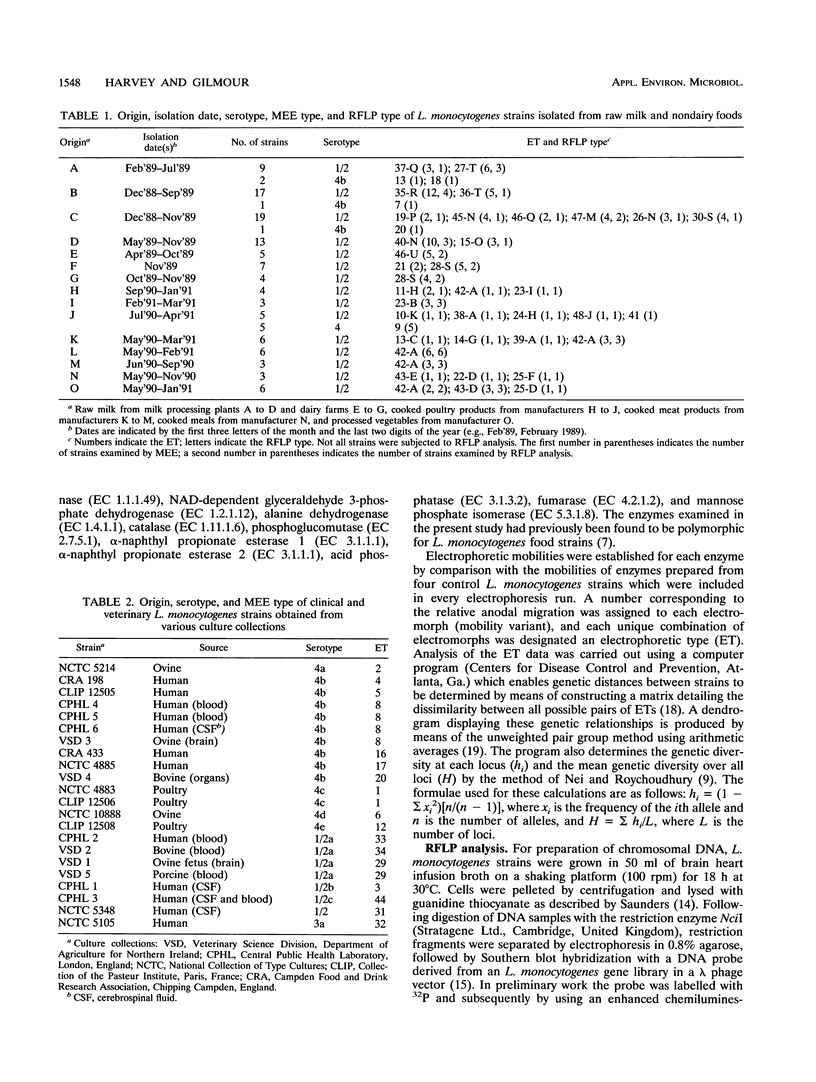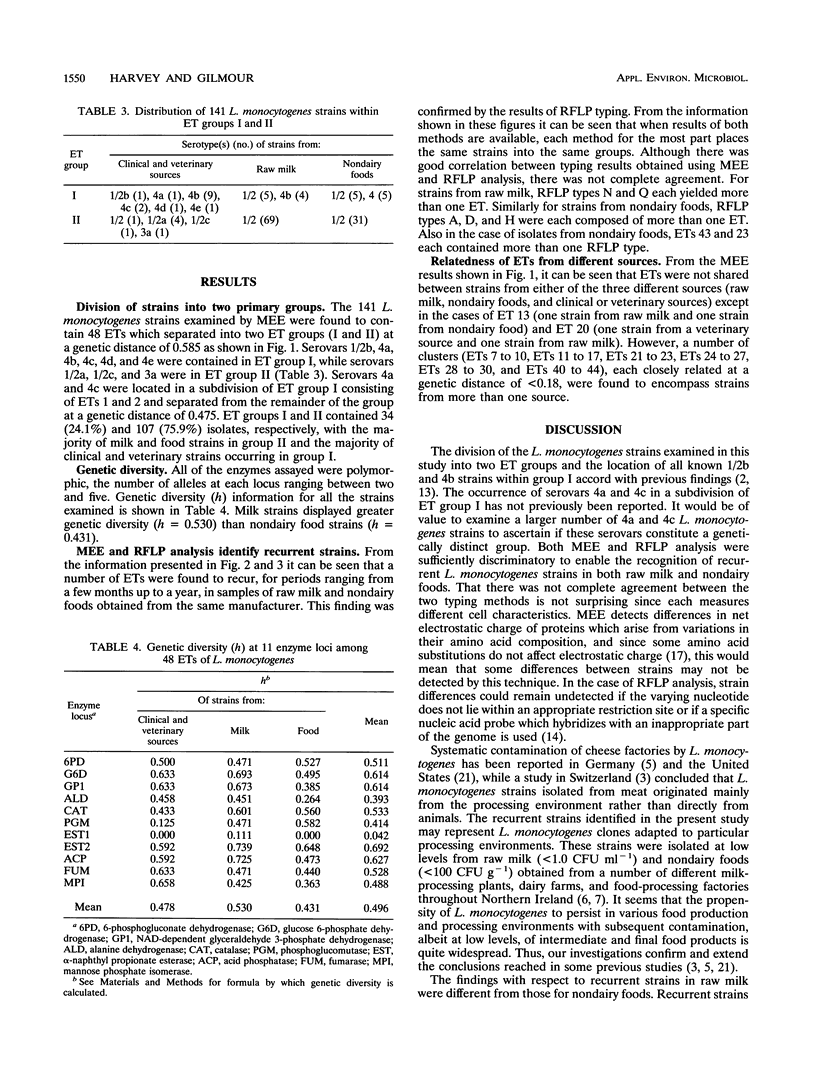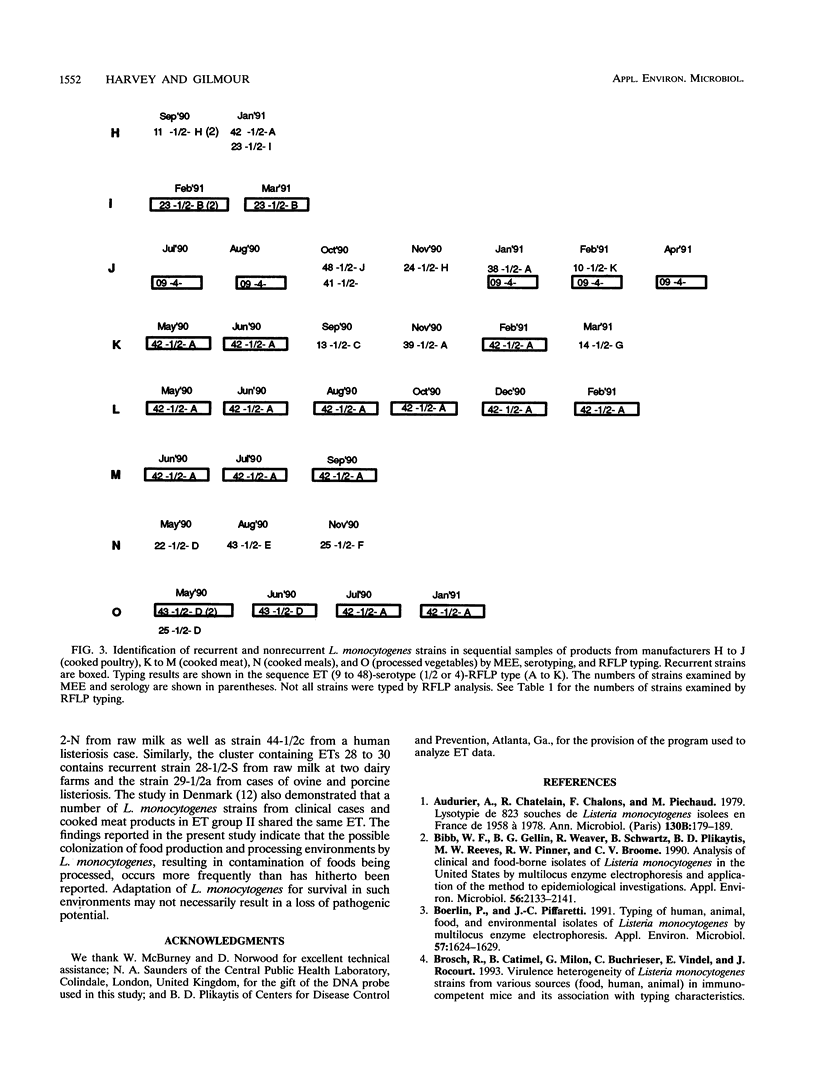Abstract
The powerful discriminatory typing capabilities of multilocus enzyme electrophoresis and restriction fragment length polymorphism analysis were applied to Listeria monocytogenes strains from raw milk, nondairy foods, and clinical and veterinary sources. The raw milk and nondairy food strains were sequential isolates obtained over a year-long period from a number of different producers and manufacturers. Results obtained by the two typing methods were in substantial agreement and showed that both raw milk and nondairy foods frequently contain recurrent L. monocytogenes strains, thus suggesting that the presence of these organisms in such commodities often arises because of contamination from within their respective processing environments. Most recurrent strains were serogroup 1/2, with only one instance of recurrent serogroup 4 strains. Some recurrent L. monocytogenes strains, including the serogroup 4 strains, were found by analysis of multilocus enzyme electrophoresis results to be closely related to clinical and veterinary strains, thus suggesting that strains adapted for survival in the food-processing environment retain their potential for pathogenicity.
Full text
PDF






Selected References
These references are in PubMed. This may not be the complete list of references from this article.
- Audurier A., Chatelain R., Chalons F., Piéchaud M. Lysotypie de 823 souches de listeria monocytogenes isolées en France de 1958 à 1978. Ann Microbiol (Paris) 1979 Aug-Sep;130B(2):179–189. [PubMed] [Google Scholar]
- Bibb W. F., Gellin B. G., Weaver R., Schwartz B., Plikaytis B. D., Reeves M. W., Pinner R. W., Broome C. V. Analysis of clinical and food-borne isolates of Listeria monocytogenes in the United States by multilocus enzyme electrophoresis and application of the method to epidemiologic investigations. Appl Environ Microbiol. 1990 Jul;56(7):2133–2141. doi: 10.1128/aem.56.7.2133-2141.1990. [DOI] [PMC free article] [PubMed] [Google Scholar]
- Boerlin P., Piffaretti J. C. Typing of human, animal, food, and environmental isolates of Listeria monocytogenes by multilocus enzyme electrophoresis. Appl Environ Microbiol. 1991 Jun;57(6):1624–1629. doi: 10.1128/aem.57.6.1624-1629.1991. [DOI] [PMC free article] [PubMed] [Google Scholar]
- Harvey J., Gilmour A. Occurrence and characteristics of Listeria in foods produced in Northern Ireland. Int J Food Microbiol. 1993 Aug;19(3):193–205. doi: 10.1016/0168-1605(93)90077-t. [DOI] [PubMed] [Google Scholar]
- Harvey J., Gilmour A. Occurrence of Listeria species in raw milk and dairy products produced in Northern Ireland. J Appl Bacteriol. 1992 Feb;72(2):119–125. doi: 10.1111/j.1365-2672.1992.tb01812.x. [DOI] [PubMed] [Google Scholar]
- Hof H., Rocourt J. Is any strain of Listeria monocytogenes detected in food a health risk? Int J Food Microbiol. 1992 Jul;16(3):173–182. doi: 10.1016/0168-1605(92)90078-h. [DOI] [PubMed] [Google Scholar]
- Nei M., Roychoudhury A. K. Sampling variances of heterozygosity and genetic distance. Genetics. 1974 Feb;76(2):379–390. doi: 10.1093/genetics/76.2.379. [DOI] [PMC free article] [PubMed] [Google Scholar]
- Nocera D., Bannerman E., Rocourt J., Jaton-Ogay K., Bille J. Characterization by DNA restriction endonuclease analysis of Listeria monocytogenes strains related to the Swiss epidemic of listeriosis. J Clin Microbiol. 1990 Oct;28(10):2259–2263. doi: 10.1128/jcm.28.10.2259-2263.1990. [DOI] [PMC free article] [PubMed] [Google Scholar]
- Nørrung B. Characterisation of Danish isolates of Listeria monocytogenes by multilocus enzyme electrophoresis. Int J Food Microbiol. 1992 Jan-Feb;15(1-2):51–59. doi: 10.1016/0168-1605(92)90135-p. [DOI] [PubMed] [Google Scholar]
- Nørrung B., Skovgaard N. Application of multilocus enzyme electrophoresis in studies of the epidemiology of Listeria monocytogenes in Denmark. Appl Environ Microbiol. 1993 Sep;59(9):2817–2822. doi: 10.1128/aem.59.9.2817-2822.1993. [DOI] [PMC free article] [PubMed] [Google Scholar]
- Piffaretti J. C., Kressebuch H., Aeschbacher M., Bille J., Bannerman E., Musser J. M., Selander R. K., Rocourt J. Genetic characterization of clones of the bacterium Listeria monocytogenes causing epidemic disease. Proc Natl Acad Sci U S A. 1989 May;86(10):3818–3822. doi: 10.1073/pnas.86.10.3818. [DOI] [PMC free article] [PubMed] [Google Scholar]
- Saunders N. A., Ridley A. M., Taylor A. G. Typing of Listeria monocytogenes for epidemiological studies using DNA probes. Acta Microbiol Hung. 1989;36(2-3):205–209. [PubMed] [Google Scholar]
- Selander R. K., Caugant D. A., Ochman H., Musser J. M., Gilmour M. N., Whittam T. S. Methods of multilocus enzyme electrophoresis for bacterial population genetics and systematics. Appl Environ Microbiol. 1986 May;51(5):873–884. doi: 10.1128/aem.51.5.873-884.1986. [DOI] [PMC free article] [PubMed] [Google Scholar]
- Selander R. K., McKinney R. M., Whittam T. S., Bibb W. F., Brenner D. J., Nolte F. S., Pattison P. E. Genetic structure of populations of Legionella pneumophila. J Bacteriol. 1985 Sep;163(3):1021–1037. doi: 10.1128/jb.163.3.1021-1037.1985. [DOI] [PMC free article] [PubMed] [Google Scholar]
- Trott D. J., Robertson I. D., Hampson D. J. Genetic characterisation of isolates of Listeria monocytogenes from man, animals and food. J Med Microbiol. 1993 Feb;38(2):122–128. doi: 10.1099/00222615-38-2-122. [DOI] [PubMed] [Google Scholar]
- Wesley I. V., Ashton F. Restriction enzyme analysis of Listeria monocytogenes strains associated with food-borne epidemics. Appl Environ Microbiol. 1991 Apr;57(4):969–975. doi: 10.1128/aem.57.4.969-975.1991. [DOI] [PMC free article] [PubMed] [Google Scholar]


